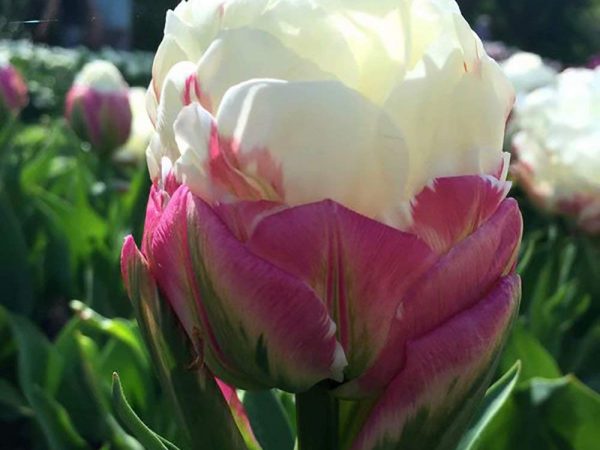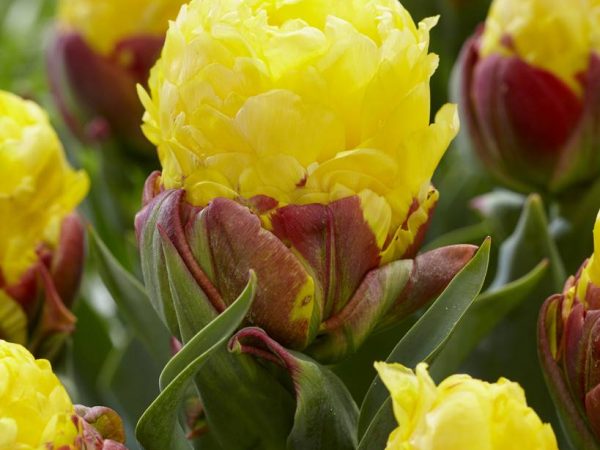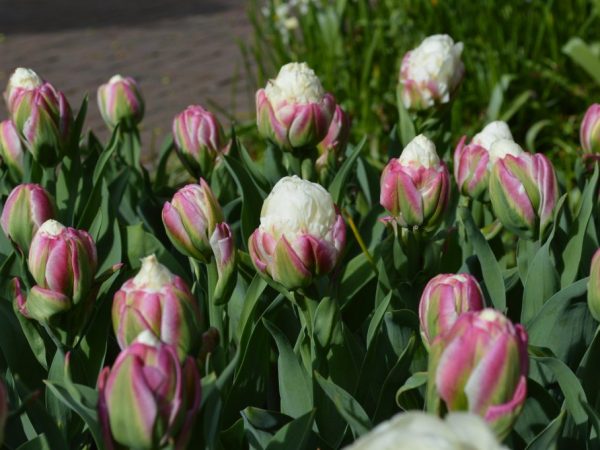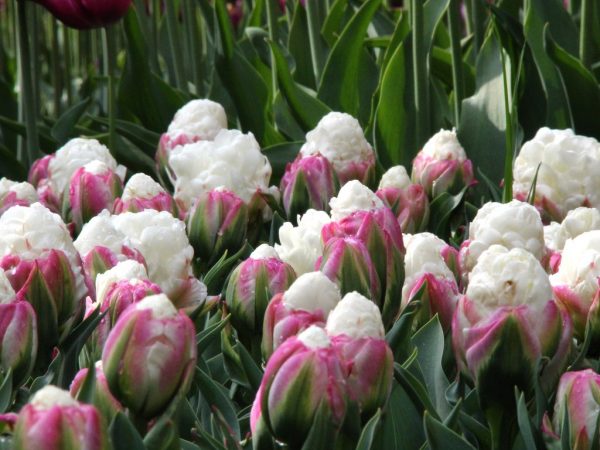Tulip Ice Cream - cultivation features
The Ice Cream (or ice cream) double tulip is one of the most attractive and long-flowering bulbous plants. It is an old Dutch variety that was first mentioned in the early 17th century. Consider its main characteristic, the rules of cultivation and care.
- Description of colors
- Landing features
- Timing
- Place and soil
- Preparation of planting material
- Landing technique
- Basic care
- Watering and loosening
- Top dressing
- Care during and after flowering
- Transfer
- Digging and storage
- Diseases and pests
- Gray rot
- Root rot
- Tifulez
- Variegated
- August disease
- Blind buds
- Calcareous disease
- Root mite
- Greenhouse aphid
- Onion hoverfly
- Application in landscape design
- Testimonials
- Useful videos

Ice cream tulip
Description of colors
The botanical name of the variety is Double Tulip Ice Cream.
Ice cream in English means "ice cream". This name was chosen for a reason - the buds of this tulip look unusual and resemble a creamy delicacy. They are terry, with a diameter of 8-12 cm, when opened they have a hemispherical shape.
The inner petals are snow-white, and the outer ones are small, pink and orange with green longitudinal veins in the center.
The tulip blooms from mid-May to early June, thinning the pleasant aroma. The process of blooming of the inflorescence is fascinating - delicate velvety petals unfold in the likeness of peonies, thereby forming a weightless cloud.
Cut flowers last for a long time - 10-14 days.
Landing features
The successful cultivation of this crop depends on the quality of the planting material, the location and composition of the soil.

Tulip ice cream
Timing
It is better to plant the bulbs in the spring, when the street temperature stabilizes and the soil warms up to 8-9 ° C (at the beginning or in the middle of March).
Place and soil
This culture prefers to grow on loamy soil with a high content of minerals and organic matter. The soil should be well-drained and neutral in acidity.
If the indicator is higher than 6 units, add 350 g / m² of slaked lime, dolomite flour or calcite.
The place should be well lit by the sun, since in the shade the tulip will grow slowly, and the buds will form small and pale. Does not tolerate drafts, so plant in a windless area where there is no stagnant water.
Preparation of planting material
You can buy Ice Cream tulip bulbs in one of the gardening stores. The price for one package (3 pcs.) Is 330 rubles. The best time to buy is February.
When buying, carefully inspect each copy - the husk should be dry, without mold, rot, black blotches and yellowness. The best material is considered to be solid bulbs, of the correct shape - flattened at the bottom and with a tip at the top.
Before planting, they are treated with Fundazol 0.2% to destroy all pathogenic microflora on the surface of the scales.
Landing technique
Pits are dug out at a distance of 10 cm. In each you need to fill in one handful of peat mixed with humus and dug earth in an equal amount.
Before planting, the bulbs are sorted into small, medium and large, since the planting depth will be different.It is calculated as follows - the length of the bulb is multiplied by three. For small ones about 5-6 cm, medium - 7-8 cm, large - 9-10 cm.
After planting, they are watered, sprinkled with peat, which creates additional heat and nutrition.
Basic care
They begin to care for the tulips after the sprouts appear. Several activities are required on a regular basis.

Tulips ice cream photo
Watering and loosening
The soil around the flowers is loosened to provide good moisture and oxygen access. This procedure is carried out after each humidification or rain. Watered as the soil dries up to a depth of 4-5 cm. Do not allow the earth to dry out and waterlogged.
In both cases, young shoots may die. 30 liters of water are consumed per 1 m².
The flower garden must be kept clean - periodically remove weeds, weed the soil.
Top dressing
For the entire growing season, tulips must be fed three times with mineral fertilizers. They use special preparations for growing bulbous plants - Kemira Kombi, Nitrofoska, Ammofoska or Flower Paradise. Fertilized at the beginning of the growth period, in the budding phase and during flowering.
When making liquid solutions, it is important to exclude contact with the leaves, otherwise they will get burned and turn yellow.
Care during and after flowering
At the peak of decorativeness, plants require abundant and frequent watering - 10 liters per 1 m² and the application of the above fertilizers. You also need to periodically inspect the buds for wilting, disease and pests. Such flowers must be removed.
After the flowers dry up, tulips continue to water abundantly for another two weeks, since during this period, the formation of bulbs occurs.
Cutting of stems and leaves is carried out after their complete yellowing.
Transfer
This procedure is started at the end of June or at the beginning of July, when the soil is loose and does not contain much moisture.
The bulbs are dug up together with a lump of earth, the leaves and stems are cut off, the old brown husks are removed. At the end, wash with a 0.2% concentration of Fundazole disinfectant solution.
Planting material is transplanted in the fall - in the middle or at the end of September.
Digging and storage
The plant is frost-resistant - it can withstand temperatures down to -30 ° C, so spring frosts are not terrible for planting material.

Tulips ice cream photo
The bulbs are dug out in order to dispose of diseased plants, to select high-quality and healthy specimens for further cultivation and preservation of the variety. Depending on the climatic conditions, the digging time is different - from the end of May to the first half of June. You should be guided by the color of the leaves. As soon as they turn yellow 2/3 of the length, the planting material can be removed.
To preserve it until spring, it is necessary to clean it well of soil, foliage remnants, old husks and dry it thoroughly. For a couple of days they are placed in boxes for ventilation and placed in a shady place.
Optimal storage conditions:
- the temperature is in the range of 23-25 ° С, closer to winter it is lowered to 15 ° С;
- good ventilation;
- low air humidity - 55-60%.
The bulbs are laid in layers in a box, sprinkled with sawdust. The second storage option is to wrap each copy with a newspaper, then put it in a container for preservation.
They should be regularly inspected for rot and mold - damaged bulbs must be disposed of.
Diseases and pests
In the process of growth and development, ice cream tulips can be exposed to various infections and parasites, with timely detection and treatment, the flowers can be saved.

Tulip ice cream photo
Gray rot
Appears in wet and rainy weather. It appears as yellowish-brown spots on stems, foliage and bulbs. Treatment is carried out by irrigating flowers with a solution of Bordeaux liquid (1%). 150 ml is spent on the treatment of a 1 m² plot.
Root rot
Partial decay of the bulbs, as a result of which the above-ground part loses its decorative effect.Infected tulips are treated with a strong solution of potassium permanganate or Fundazol - 10 g per 10 liters of water.
Tifulez
Adult tulips suspend development and flowering, young shoots acquire a reddish or brownish tint, inflorescences develop small, take on an ugly shape. This disease is not subject to treatment. Therefore, the flowers are dug up and disposed of along with the bulbs.
For prevention, you should regularly loosen the soil, remove weeds and dig up the site every fall.
Variegated
A viral disease that is transmitted through juice in injured areas. The color of the buds changes. There are no drugs for treatment at the moment, so sick specimens are dug up and burned.
August disease
Leaves and stems are covered with strokes. The affected areas die off, as a result of this, the flower dies. A sick tulip is dug up and disposed of together with an earthen clod.
Blind buds
This non-infectious disease damages flowers during the forcing period. To prevent infection, it is necessary to select high-quality and healthy planting material, to observe the timing of its planting.
This sore cannot be treated. Infected tulips are disposed of, and the place of growth is spilled with copper sulfate.
Calcareous disease
The bulbs harden, change their natural color to white - such planting material is not suitable for further cultivation.
In order to avoid infection, it is necessary to dig up flowers in time and follow the rules for their storage.
Root mite
This parasite damages the tissue of the bulb, penetrating inside through the scales, as a result of which it begins to rot. To prevent the appearance of the pest, it is necessary to lower the bulbs in warm water (40 ° C) before planting, then treat with Aktellik.
Greenhouse aphid
It feeds on the sap of leaves, petals and stems, leading to their deformation, wilting and drying out. In the fight against this parasite, Inta-vir or Fitoverm are used. To prevent an invasion, it is necessary to plant marigolds, dope or calendula between the tulips. They thin out a specific scent that repels insects.
Onion hoverfly
Fly larvae damage the bulb; as a result, the tulip stops growing and dies. Sick specimens are dug up and disposed of. Infection can be prevented if the planting material is treated with Fundazole.
Application in landscape design
This decorative flower is very popular in both industrial and private landscaping:

Tulip ice cream photo price
- planted in groups in flower beds, in flower beds in the foreground;
- combined with other flowering plants and tulip varieties;
- planted along curbs, in alleys, used to create bright mixborders;
- grown in the center of the personal plot and in its remote places, where there is good lighting.
In floristry, they are used to design original and beautiful compositions, decorations and bouquets.
Testimonials
Ice Cream tulips are loved by many growers. They bloom for a long time and remain in the cut for about two weeks. They are compact in size and do not take up much space on the site.
Suitable for combination with other decorative vegetation, therefore it is used in garden decoration in different styles. With good care and maintenance, they practically do not get sick.

